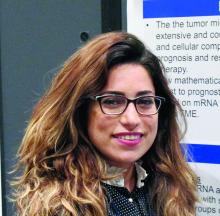ORLANDO – , according to new research.
Yara Abdou, MD, of Roswell Park Comprehensive Cancer Center in Buffalo, N.Y., and colleagues presented this work in a poster at the ASCO-SITC Clinical Immuno-Oncology Symposium.
The model used 50 cycles of machine learning to cluster 98 patients from The Cancer Genome Atlas Program into high- and low-risk groups based on mRNA expression of 26 gene groups.
The gene groups consisted of 191 genes enriched in cellular and noncellular elements of the tumor microenvironment. Mutational burden and clinical outcomes data for the patients also were considered, Dr. Abdou explained in an interview.
Kaplan-Meier curves were created for each group by K-means clustering, survival differences between the two groups were assessed, and correlations among the various gene groups were analyzed.
Five identified genes were associated with poor prognosis: LOXL2, PHEX, ACTA2, MEGF9, and TNFSF4. Fifteen genes were associated with good prognosis: CD8A, CD8B, FCRL3, GZMK, CD3E, CCL5, TP53, ICAM3, CD247, IFNG, IFNGR1, ICAM4, SHH, HLA-DOB, and CXCR3.
The Kaplan-Meier curves showed a significant difference in survival between the two groups (hazard ratio, 2.878; P = .05), confirming the validity of the risk score modeling, Dr. Abdou said.
Immune profiling showed that expression of genes associated with desmoplastic reaction, neutrophils, and immunosuppressive cytokines were higher in the high-risk group, whereas expression of genes related to immune system activation were higher in the low-risk group (P less than .05).
Stroma in the tumor microenvironment is known to affect prognosis and response to therapy in patients with breast cancer, but few mathematical models exist to determine prognosis based on mRNA expressivity in the tumor microenvironment, Dr. Abdou said, explaining the rationale for the study.
The findings suggest that when genomic profile information is available for a given patient in the clinic, this machine learning–assisted risk scoring approach could have prognostic value, she said, noting that the model also will be assessed in patients with other types of breast cancer.
Dr. Abdou reported having no disclosures.
SOURCE: Abdou Y et al. ASCO-SITC. Poster A3.


